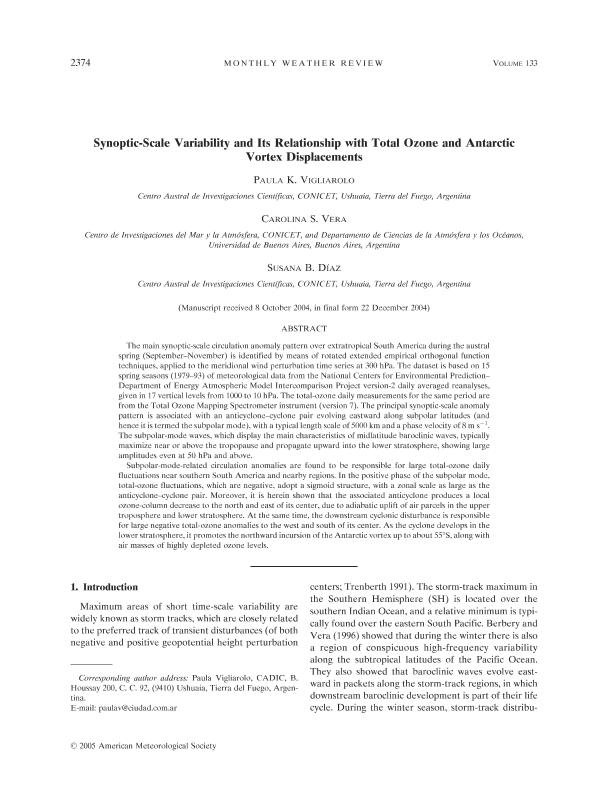Artículo
Synoptic-scale variability and its relationship with total ozone and Antarctic vortex displacements
Fecha de publicación:
08/2005
Editorial:
American Meteorological Society
Revista:
Monthly Energy Review
ISSN:
0027-0644
Idioma:
Inglés
Tipo de recurso:
Artículo publicado
Clasificación temática:
Resumen
The main synoptic-scale circulation anomaly pattern over extratropical South America during the austral spring (September-November) is identified by means of rotated extended empirical orthogonal function techniques, applied to the meridional wind perturbation time series at 300 hPa. The dataset is based on 15 spring seasons (1979-93) of meteorological data from the National Centers for Environmental Prediction-Department of Energy Atmospheric Model Intercomparison Project version-2 daily averaged reanalyses, given in 17 vertical levels from 1000 to 10 hPa. The total-ozone daily measurements for the same period are from the Total Ozone Mapping Spectrometer instrument (version 7). The principal synoptic-scale anomaly pattern is associated with an anticyclone-cyclone pair evolving eastward along subpolar latitudes (and hence it is termed the subpolar mode), with a typical length scale of 5000 km and a phase velocity of 8 m s-1. The subpolar-mode waves, which display the main characteristics of midlatitude baroclinic waves, typically maximize near or above the tropopause and propagate upward into the lower stratosphere, showing large amplitudes even at 50 hPa and above. Subpolar-mode-related circulation anomalies are found to be responsible for large total-ozone daily fluctuations near southern South America and nearby regions. In the positive phase of the subpolar mode, total-ozone fluctuations, which are negative, adopt a sigmoid structure, with a zonal scale as large as the anticyclone-cyclone pair. Moreover, it is herein shown that the associated anticyclone produces a local ozone-column decrease to the north and east of its center, due to adiabatic uplift of air parcels in the upper troposphere and lower stratosphere. At the same time, the downstream cyclonic disturbance is responsible for large negative total-ozone anomalies to the west and south of its center. As the cyclone develops in the lower stratosphere, it promotes the northward incursion of the Antarctic vortex up to about 55°S, along with air masses of highly depleted ozone levels.
Archivos asociados
Licencia
Identificadores
Colecciones
Articulos(CADIC)
Articulos de CENTRO AUSTRAL DE INVESTIGACIONES CIENTIFICAS
Articulos de CENTRO AUSTRAL DE INVESTIGACIONES CIENTIFICAS
Articulos(CIMA)
Articulos de CENTRO DE INVESTIGACIONES DEL MAR Y LA ATMOSFERA
Articulos de CENTRO DE INVESTIGACIONES DEL MAR Y LA ATMOSFERA
Articulos(INGEBI)
Articulos de INST.DE INVEST.EN ING.GENETICA Y BIOL.MOLECULAR "DR. HECTOR N TORRES"
Articulos de INST.DE INVEST.EN ING.GENETICA Y BIOL.MOLECULAR "DR. HECTOR N TORRES"
Citación
Vigliarolo, Paula Karina; Vera, Carolina Susana; Diaz, Susana Beatriz; Synoptic-scale variability and its relationship with total ozone and Antarctic vortex displacements; American Meteorological Society; Monthly Energy Review; 133; 8; 8-2005; 2374-2386
Compartir
Altmétricas




